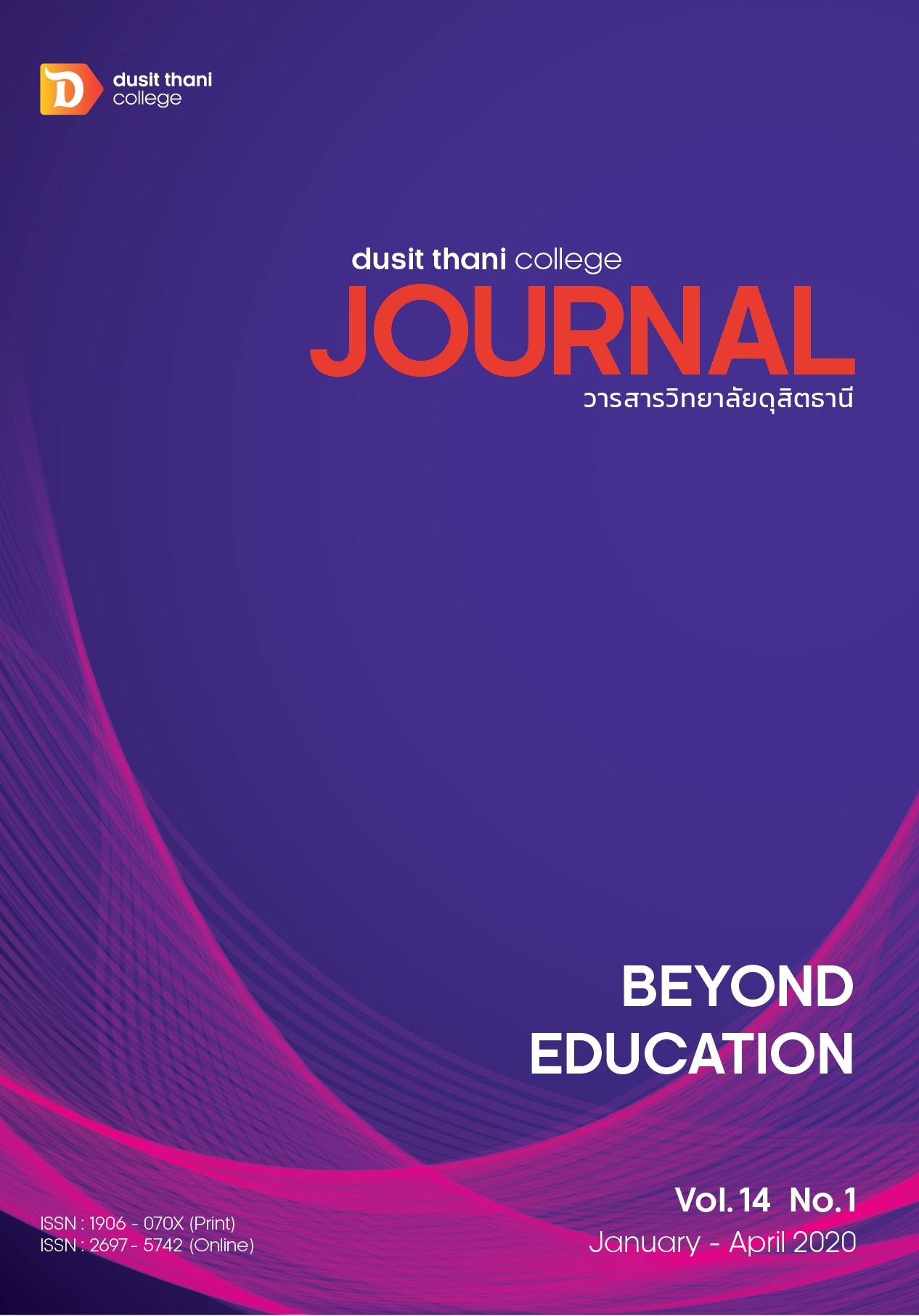การแบ่งกลุ่มตามความนิยมทางกีฬาเพื่อความเข้าใจนักท่องเที่ยวเชิงกีฬาสตรีชาวไทย
Main Article Content
บทคัดย่อ
การมีส่วนร่วมและความนิยมในกีฬาของสตรีเพิ่มขึ้นอย่างมากในศตวรรษที่ 21 ซึ่งก่อให้เกิดประโยชน์ทางเศรษฐกิจและสังคมอย่างมากต่อเมืองเจ้าภาพที่จัดงานกีฬา ซึ่งนำไปสู่แนวคิดการท่องเที่ยวอย่างยั่งยืน วัตถุประสงค์ของการศึกษาครั้งนี้มี 3 ข้อ ประกอบด้วย วัตถุประสงค์ข้อแรก สำรวจข้อมูลส่วนบุคคล แรงจูงใจ และความจงรักภักดีต่องานวิ่งของนักท่องเที่ยวเชิงกีฬาสตรีชาวไทย วัตถุประสงค์ข้อที่สอง ศึกษาสัดส่วนของผู้เข้าร่วมงานที่มีความชื่นชอบทางกีฬาที่แตกต่างกัน วัตถุประสงค์ข้อที่สาม ศึกษาความแตกต่างของกลุ่มผู้ที่ชื่นชอบในกีฬาที่แตกต่างกันต่อ ข้อมูลส่วนบุคคล แรงจูงใจ และความจงรักภักดีต่องานวิ่ง การศึกษาครั้งนี้ได้จำแนกผู้เข้าร่วมงานขอนแก่นมาราธอนนานาชาติปี 2561 จำนวน 415 คน ออกเป็น 4 กลุ่ม วิธีการทดสอบแบบตารางไขว้ (Crosstabulations) และไคสแควร์ (Chi-square) ถูกนำมาจำแนกผู้เข้าร่วมงานตามความชื่นชอบด้านกีฬา นอกจากนี้ยังใช้วิธีการทดสอบ ANOVA และไคสแควร์ เพื่อทดสอบความแตกต่างระหว่างกลุ่มผู้เข้าร่วมงานที่มีระดับความชื่นชอบกีฬาที่แตกต่างกันข้อมูลส่วนตัว แรงจูงใจ และความจงรักภักดีต่องานวิ่งที่ระดับนัยสำคัญ 0.05 ผลการศึกษาพบว่า รูปแบบนักท่องเที่ยวเชิงกีฬาสตรีชาวไทยมีสถานะโสด อายุเฉลี่ย 28 ปี เป็นนักศึกษา มีการศึกษาดี มีฐานะค่อนข้างดี และมีถิ่นพำนักในจังหวัดที่จัดงานวิ่ง แรงจูงใจสามอันดับแรก คือ สุขภาพ การได้รับประสบการณ์ใหม่ และสถานที่ตั้งของการจัดงานวิ่ง ผู้เข้าร่วมงานมีแนวโน้มอย่างมากที่จะกลับมาเยือนอีกครั้งและสื่อสารแบบปากต่อปาก สัดส่วนหลักของผู้เข้าร่วมงานคือ กลุ่มนักวิ่งเริ่มต้น (the Beginner) ระดับความชื่นชอบทางกีฬามีความแตกต่างมีความแตกต่างอย่างมีนัยสำคัญต่อ ข้อมูลส่วนบุคคล แรงจูงใจ และความจงรักภักดีต่องานวิ่ง
Article Details
นโยบายการพิจารณากลั่นกรองบทความ
- บทความวิจัยและบทความวิชาการทุกเรื่องที่จะได้รับการตีพิมพ์ต้องผ่านการพิจารณากลั่นกรองโดยผู้ทรงคุณวุฒิ (Peer Review) ในสาขาที่เกี่ยวข้อง จำนวน 3 ท่าน/บทความ
- บทความ ข้อความ ภาพประกอบและตารางประกอบที่ลงตีพิมพ์ในวารสารเป็นความคิดเห็นส่วนตัวของผู้เขียน กองบรรณาธิการไม่จำเป็นต้องเห็นด้วยเสมอไป และไม่มีส่วนรับผิดชอบใด ๆ ถือเป็นความรับผิดชอบของผู้เขียนแต่เพียงผู้เดียว
- บทความที่จะได้รับการตีพิมพ์จะต้องไม่เคยตีพิมพ์ เผยแพร่ที่ใดมาก่อน และไม่อยู่ระหว่างการพิจารณาของวารสารฉบับอื่น หากตรวจสอบพบว่ามีการตีพิมพ์ซ้ำซ้อน ถือเป็นความรับผิดชอบของผู้เขียนแต่เพียงผู้เดียว
- บทความใดที่ผู้อ่านเห็นว่าได้มีการลอกเลียนหรือแอบอ้างโดยปราศจากการอ้างอิง หรือทำให้เข้าใจผิดว่าเป็นผลงานของผู้เขียน กรุณาแจ้งให้กองบรรณาธิการวารสารทราบจะเป็นพระคุณยิ่ง
เอกสารอ้างอิง
2. Baloglu, S. & McCleary, K. W. (1999). A model of destination image formation. Annals of Tourism Research Research, 26, 868 - 897.
3. Booth, D. & Loy, J. (1999). Sport, status, and style. Sport History Review, 30(1), 1 - 26.
4. Boutilier, M. & SanGiovanni, L. (1983). The Sporting Women: Feminist and Sociological Dilemmas, Human Kinetics, Champaign, II.
5. Bureau of the Census. (1995). Statistical Abstracts of the US, 1995: The National Data Book, 115th Ed., Bureau of the Census, Washington DC.
6. Cassidy, F. (2005). What motivates sports event tourists?: a synthesis of three disciplines. Paper presented at the Women in Research Conference 2005: Women Doing Research, Gladstone, Australia.
7. Chalip, L. & Green, B. C. (2001). Event marketing and destination image. Paper presented at the AMA Educators’ Proceedings, Summer.
8. Chon, K. S & Sparrowe, Raymond T., (2000). Welcome to hospitality: an introduction (2nd ed). Delmar, Albany, N.Y
9. Crompton, J. (1979). Motivations for pleasure vacation. Annals of Tourism Research Travel Research, 6, 408 - 424.
10. Deery, M., Jago, L. & Fredline, L. (2004). Sport tourism or event tourism: are they one and the same? Journal of Sport Tourism, 9(3), 235 - 245.
11. De Knop, P. (1990). Sport for all and active tourism. World Leisure and Recreation, 32, 30 - 36.
12. De Knop, P. (1998). Sport tourism: a state of the art. European Journal for Sport Management, 5(2), 5-20.
13. Delpy, L. (1998). An overview of sport tourism: Building towards a dimensional framework. Journal of Vacation Marketing, 4, 23 - 38.
14. Gibson, H. J. (1998). Sport Tourism: A critical analysis of research. Sport Management
Review, 1: 45 - 76.
15. Gibson, H. J. (2003). Sport Tourism: An Introduction to the Special Issue. Journal of Sport Management, 17: 205 - 213.
16. Gibson, H., Attle, S. & Yiannakis, A. (1997). Segmenting the sport tourist market: a lifespan perspective. Paper presented at Teaming for Success: A Forum on Sport Tourism, 6-8 March, Arlington, VA.
17. Gibson, H. J. & Yiannakis, A. (2002). Tourist roles: needs and the adult life course. Annals of Tourism Research, 29: 358 - 383.
18. Greendorfer, S. (1979). Differences in childhood socialization influences of women involved in sport and women not involved in sport. In M.L. Krotee (Ed.), The Dimensions of Sport Sociology, West point, NY: Leisure Press.
19. Green, B. C. & Chalip, L. (1998). Sport tourism as the celebration of subculture. Annals of Tourism Research, 25: 275 - 291.
20. Hinch, T. & Higham, J. (2004). Sport tourism development. Tonawanda, NY: Channel View Publications.
21. Homafar, F., Honari, H . & Heidary, A. (2011). The role of sport tourism in employment, income and economic development. Journal of Hospitality Management and Tourism, 2(3), 34 - 37.
22. Job, H. (2008). Estimating the regional economic impact of tourism to national parks: Two case studies from Germany. GAIA, 17(S1), 134 - 142.
23. Kaae, B. & Lee, R. (1996). The Use of Lifestyle in Outdoor Recreation Research. Paper presented at the 1996 World Congress of the World Leisure and Recreation Association, 15-19 July, Cardiff, Wales, UK.
24. Kaplanidou, K. & Vogt, C. (2007). The Interrelationship between sport event and destination image and sport tourist’s behaviours. Journal of Sport & Tourism, 12: 183 - 206.
25. Kidd, B. (1995). Inequality in sport, the corporation, and the state: an agenda for social scientists. Journal of Sport & Social Issues , 19(3): 232 - 248.
26. Kotler, P. & Keller, K. (2006). Marketing Management. 12th Ed., Prentice Hall, Upper Saddle River.
27. Küpfer, I. (2000). Die regionalwirtschaftliche Bedeutung des Nationalparktourismus: Untersucht am Beispiel des Schweizerischen Nationalparks [The regional economic impact of the National Park Tourism: a case of the Swiss National Park]. Zernez: Nationalparkforschung Schweiz.
28. Kurtzman, J. (2005). Sports tourism categories. Journal of Sport & Tourism, 10 (1): 15 - 20.
29. Kurtzman, J. & Zauhar, J. (2003). A wave in time - the sports tourism phenomena.
Journal of Sport & Tourism, 1: 35 - 47.
30. Kurtzman, J. & Zauhar, J. (2005). Sports tourism consumer motivation. Journal of Sport & Tourism, 10: 21 - 31.
31. Mason, P. (1990). Tourism: Environment and Development Perspectives. Godalming, UK, World Wide Fund for Nature.
32. Mayer, M., Müller, M., Woltering, M., Arnegger, J., & Job, H. (2010). The economic impact of tourism in six German national parks. Landscape and Urban Planning, 97(2), 73 - 82.
33. Nogowa, H., Yamguchi, Y. & Hagi, Y. (1996). An empirical research study on Japanese sport tourism in sport-for-all events: case studies of a single-night event and a multiple-night event. Journal of Travel Research, 35(2): 46 - 54.
34. Schreiber, R. (1976). Sports interest: A travel definition. The Travel Research Association 7th Annual Conference Proceedings, Boca Raton, FL: TTRA, 85 - 87.
35. Swart, K., & Bob, U. (2007). The eluding link: toward developing a national sport tourism strategy in South Africa beyond 2010. Politikon, 34, 373 - 391.
36. Tassiopoulosa, D. & Haydamb, N. (2007). Golf tourists in South Africa: A demand-side study of a niche market in sports Tourism. Tourism Management Journal, 29(5): 870 - 882.
37. Walmsley, D.J. & Young, M. (1998). Evaluative images and tourism: The use of personal constructs to describe the structure of destination images. Journal of Travel Research, 36(3): 65 - 69.


